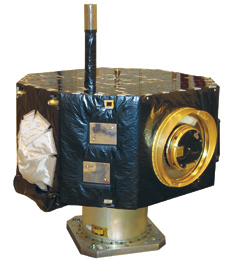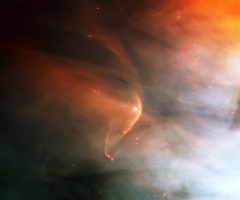Mapping the Galactic Frontier
LONG BEFORE NASA’s Interstellar Boundary Explorer satellite is secured inside a winged Pegasus rocket and cinched to the belly of an Air Force L-1011 widebody jet, the little spacecraft receives the same treatment your car tires get down at the local garage.
Earlier this spring, IBEX was bolted to a huge spin table at Vandenberg Air Force Base in California and whirled around with various stages of the Pegasus. This spin balancing assures the 28-inch-tall by 38-inch-wide, octagonal satellite won’t wobble uncontrollably in space, ruining its seminal mission to map the boundary between our solar system and interstellar space.
A spate of such mundane, pre-launch activities is standard operating procedure for satellite-based science missions and is the reason why UNH principal investigator Eberhard Möbius and his team of Space Science Center scientists, engineers, and students had to deliver their IBEX goods long before the Pegasus blasts off its L-1011 launch pad, which is slated for September as Spheres goes to press.
Says Möbius, “You use the reserve time that’s built into every project because you anticipate unanticipated snags, which often happen if you build such challenging new instrumentation as we have with IBEX.”
For example, there have been a series of “mission rehearsals” similar to the theatrical variety where any potential flubs can be caught and remedied well before showtime. In a clean room, the satellite was put through the paces of powering-up all systems and communicating with the delicate sensors that will soon be gathering data in an orbit up to 198,000 miles or 50 Earth radii from home (the Moon orbits at a distance of 60 Earth radii).
IBEX is one of NASA’s Small Explorer Program missions, which by design are more highly focused and less expensive than bigger satellite missions shot into space from a ground-based rocket. For example, Möbius notes, were IBEX lofted into space with a beefy, 127-foot Delta II rocket, the launch alone would rival the cost of the entire IBEX mission, which is led by the Southwest Research Institute of San Antonio, Texas.
But to properly do its science, which involves capturing atoms barreling towards Earth from the very edge of our solar system, IBEX must get into a highly elliptical Earth orbit that takes the spacecraft relatively close to the Moon. Such an orbit cannot be achieved from the belly of a big jetliner—IBEX needs an extra kick to send it on its way—and such a post-Pegasus kick-start has never been tried before.
“So you push the limits,” Möbius says. Mission scientists and engineers came up with a unique delivery system—a little rocket attached to the satellite itself—that will push IBEX into its higher orbit without pushing the budget up.
“This method will be demonstrated for the first time with IBEX and I think there’s at least one other mission interested in using the same approach,” Möbius says adding, “so we will be opening a new means of achieving a higher Earth orbit.”
IBEX’s big elliptical orbit around Earth is needed in order for the spacecraft to get far away from the background “noise” of our planet’s magnetosphere, which also generates the energetic neutral atoms that are the satellite’s quarry.
Specifically, IBEX will be capturing and recording these same atoms from a region in space where the solar wind collides with interstellar gas to form the termination shock—the boundary of the huge, magnetic bubble that surrounds the Sun (and the solar counterpart of our magnetosphere) known as the heliosphere.
Using two, ultra-high sensitivity cameras containing components built at the Space Science Center, IBEX will, for the first time, produce a full-sky map of this region. The map will, among other things, provide modelers with the real-world constraints needed to better understand how the shock is formed, and how and where these energetic atoms are accelerated.
More broadly, the IBEX data will help scientists understand the underlying physics operating in this same boundary region—the astrosphere—of other stars.
Möbius notes that because the full-sky maps will be created during solar minimum, it is the hope of mission scientists that NASA will let IBEX continue to do its work after two years of successful data gathering (two years is the baseline for these smaller-scale missions).
“As we go into the rising solar maximum, when the solar wind is changing and pushing the termination shock out or bringing it in, we’d like to track those changes,” he says.
But first things first. The next step in the mission is a flight to the Kwajalein Atoll in the South Pacific where the L-1011 will wait during a 10-day launch window for the right moment (determined by the Moon’s position) to take off and jettison the Pegasus, which will in turn send its cargo on its initial journey to study the “space between the stars.”
Earlier this spring, IBEX was bolted to a huge spin table at Vandenberg Air Force Base in California and whirled around with various stages of the Pegasus. This spin balancing assures the 28-inch-tall by 38-inch-wide, octagonal satellite won’t wobble uncontrollably in space, ruining its seminal mission to map the boundary between our solar system and interstellar space.
The IBEX satellite mounted for spin testing at Orbital Sciences Corporation. Photo:Orbital Sciences Corp. |
A spate of such mundane, pre-launch activities is standard operating procedure for satellite-based science missions and is the reason why UNH principal investigator Eberhard Möbius and his team of Space Science Center scientists, engineers, and students had to deliver their IBEX goods long before the Pegasus blasts off its L-1011 launch pad, which is slated for September as Spheres goes to press.
Says Möbius, “You use the reserve time that’s built into every project because you anticipate unanticipated snags, which often happen if you build such challenging new instrumentation as we have with IBEX.”
For example, there have been a series of “mission rehearsals” similar to the theatrical variety where any potential flubs can be caught and remedied well before showtime. In a clean room, the satellite was put through the paces of powering-up all systems and communicating with the delicate sensors that will soon be gathering data in an orbit up to 198,000 miles or 50 Earth radii from home (the Moon orbits at a distance of 60 Earth radii).
IBEX is one of NASA’s Small Explorer Program missions, which by design are more highly focused and less expensive than bigger satellite missions shot into space from a ground-based rocket. For example, Möbius notes, were IBEX lofted into space with a beefy, 127-foot Delta II rocket, the launch alone would rival the cost of the entire IBEX mission, which is led by the Southwest Research Institute of San Antonio, Texas.
But to properly do its science, which involves capturing atoms barreling towards Earth from the very edge of our solar system, IBEX must get into a highly elliptical Earth orbit that takes the spacecraft relatively close to the Moon. Such an orbit cannot be achieved from the belly of a big jetliner—IBEX needs an extra kick to send it on its way—and such a post-Pegasus kick-start has never been tried before.
“So you push the limits,” Möbius says. Mission scientists and engineers came up with a unique delivery system—a little rocket attached to the satellite itself—that will push IBEX into its higher orbit without pushing the budget up.
“This method will be demonstrated for the first time with IBEX and I think there’s at least one other mission interested in using the same approach,” Möbius says adding, “so we will be opening a new means of achieving a higher Earth orbit.”
IBEX’s big elliptical orbit around Earth is needed in order for the spacecraft to get far away from the background “noise” of our planet’s magnetosphere, which also generates the energetic neutral atoms that are the satellite’s quarry.
The bow shock around a very young star in the intense, star-forming region known as the Great Nebula Orion resembles what our Sun's heliosphere would look like if we could see it from outside our solar system.Photo: NASA |
Using two, ultra-high sensitivity cameras containing components built at the Space Science Center, IBEX will, for the first time, produce a full-sky map of this region. The map will, among other things, provide modelers with the real-world constraints needed to better understand how the shock is formed, and how and where these energetic atoms are accelerated.
More broadly, the IBEX data will help scientists understand the underlying physics operating in this same boundary region—the astrosphere—of other stars.
Möbius notes that because the full-sky maps will be created during solar minimum, it is the hope of mission scientists that NASA will let IBEX continue to do its work after two years of successful data gathering (two years is the baseline for these smaller-scale missions).
“As we go into the rising solar maximum, when the solar wind is changing and pushing the termination shock out or bringing it in, we’d like to track those changes,” he says.
But first things first. The next step in the mission is a flight to the Kwajalein Atoll in the South Pacific where the L-1011 will wait during a 10-day launch window for the right moment (determined by the Moon’s position) to take off and jettison the Pegasus, which will in turn send its cargo on its initial journey to study the “space between the stars.”
by David Sims, Science Writer, Institute for the Study of Earth, Oceans, and Space. Published in Spring 2008 issue of EOS .


